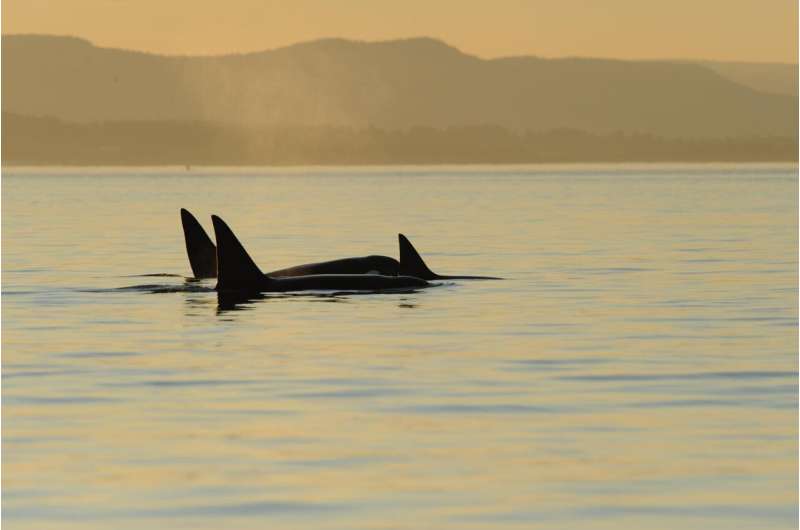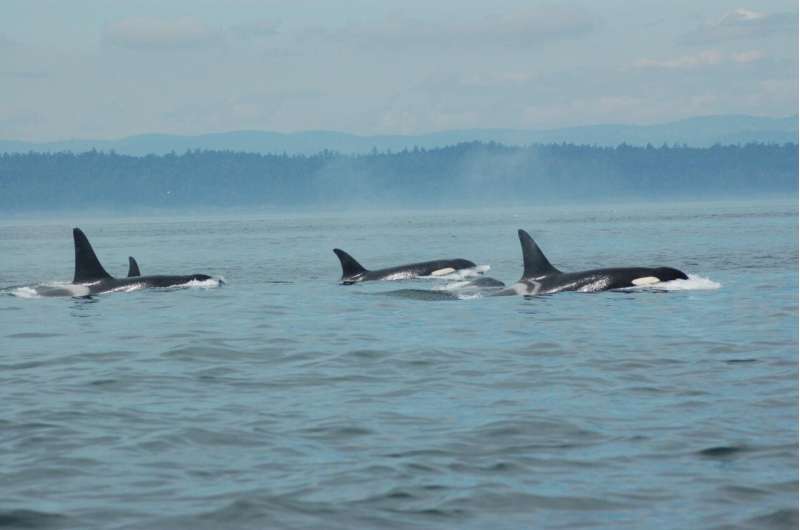New evidence of menopause in killer whales

Scientists have found new evidence of menopause in killer whales—raising fascinating questions about how and why it evolved.
Most animals breed throughout their lives. Only humans and four whale species are known to experience menopause, and scientists have long been puzzled about why this occurs.
Killer whales are a diverse species made up of multiple separate ecotypes (different types within a species) across the world's oceans that differ in their prey specialization and patterns of social behavior.
Previous studies have found menopause in an ecotype called 'resident' killer whales whose social structure appears to favor 'grandmothering' (females using their energy and knowledge to help their offspring and grand-offspring, rather than competing to breed themselves).
The new study looked at an ecotype of killer whales with a different social structure, where offspring are more likely to leave their mother—and the evolutionary benefits of grandmothering are therefore reduced.
However, menopause was found to be strikingly similar in both killer whale ecotypes.
The research was carried out by the University of Exeter, DFO Canada, the Center for Whale Research, the University of Cambridge and the University of York.
"Previous research on the evolution of menopause has focussed on resident killer whales, where both males and females usually stay in the social group into which they were born," said lead author Mia Lybkær Kronborg Nielsen, of the University of Exeter.
"As a result, females become increasingly genetically related to the other members of the group as they age."
"At birth, their father is not in their family group and their relatedness to males in the group is comparatively low, but by later life, many of the group members are their children or grandchildren, increasing their average relatedness to the group."
"The new study looks at Bigg's killer whales, which may leave their birth group around the time of maturity."

"Some sons and daughters stay with their mother, but overall we predict a weaker pattern of increased relatedness to fellow group members as a whale ages."
"We expected this to be important in terms of menopause because weaker relatedness would appear to give females a weaker evolutionary reason to cease reproduction."
Using more than 40 years of data on Bigg's and resident whales, the researchers found a similar pattern of post-reproductive life for females—accounting for more than 30% of adult years.
"These different whale populations both show increased female relatedness with age, but—as this is stronger in resident than Bigg's killer whales—it's not immediately clear why the age at menopause and the length of the post-reproductive lifespan seems to be the same in both," said Professor Darren Croft, of the University of Exeter.
"Based on theory, we would expect the effect to be stronger in resident killer whales."
"Further research using drones to study how grandmother killer whales help their offspring and grand-offspring in the different populations will allow us to investigate this, and in doing so learn more about how menopause evolved in whales and humans."
Thomas Doniol-Valcroze and Jared Towers, of DFO Canada, says that "this study highlights the value of long-term population studies in which individuals are documented throughout their lives."
"Not only do the results contribute to a better understanding of animal evolution, they have significant implications for conservation by shedding light on the importance of social structure for the recovery of these populations."
Despite living in overlapping waters in the northeast Pacific, these whale populations do not inter-breed.
The differing social structures are probably caused by prey availability.
Resident whales feed on salmon, which have historically been plentiful (though human activities have changed this), allowing the whales to live in larger groups.
Bigg's whales hunt mammals such as seals, and generally disperse into smaller groups to reduce competition—there are only so many mouths that a seal kill will feed.
More information: Mia Lybkær Kronborg Nielsen et al, A long postreproductive life span is a shared trait among genetically distinct killer whale populations, Ecology and Evolution (2021). DOI: 10.1002/ece3.7756
Journal information: Ecology and Evolution
Provided by University of Exeter



















